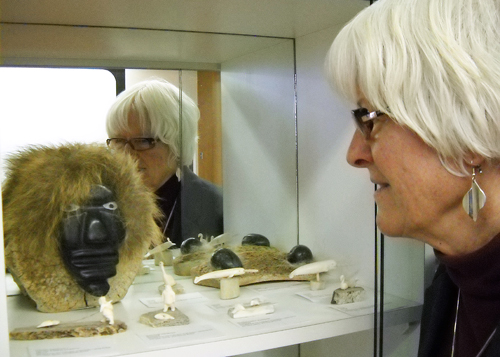
It’s a multimedia show, but not in the way you think. Stone, whalebone, textiles, ivory, antlers and animal hair: a range of materials provided inspiration for Canadian Inuit artists whose works form a major new donation to U of G’s Macdonald Stewart Art Centre (MSAC).
More than 200 items – mostly sculptures but also such pieces as shamanistic masks and a traditional beaded parka – donated by a renowned Toronto collector make the centre’s Inuit collection among the most prestigious in Canada, says Judith Nasby, MSAC director-curator.
The donation came from Beverley Borins and her family. Many of the items, including numerous unusual pieces and combinations of materials, will form a permanent display at MSAC and be accessible to gallery visitors, including Guelph fine art students.
Borins will discuss the collection May 10 at noon during a luncheon at the centre. Visitors may also view an exhibition of wall hangings and sculptures from among the roughly 700 items in the centre’s existing Inuit art collection.
Borins collected the items from many Northern Canadian communities from the 1960s to the late 1990s while running a store in downtown Toronto. Through a Toronto Inuit art dealer, she arranged to donate the pieces to Guelph.
“Her apartment was chock-a-block full of Inuit sculptures and related Inuit art,” says Nasby, who persuaded Borins to donate her custom-made display cases along with the collection. “I realized we could make a fabulous installation.”
Says Borins: “I have been very impressed with the art centre’s commitment to exhibiting, researching and publishing Inuit art. I couldn’t think of a better public gallery to receive my family’s collection.”
Nasby says the collection’s range will surprise many visitors. “Many people think of Inuit sculpture as soapstone. That’s in the minority in this particular collection.”
She points to many miniature ivory pieces, including sculpted tableaux of a tiny dogsled team complete with harnesses made of animal sinew, a hunting scene and groups of Arctic animals. Other ivory items include a crochet hook, ballpoint pen, teaspoon, cribbage board and sewing kit.
Several pieces depict unusual subjects, such as a pipe on a rack and one stone sculpture of an egg-laying bird. “It’s the first one I’ve seen of a bird laying an egg,” says Nasby.
One of her favourite mythological pieces in the collection is a five-eyed shaman drum dancer carved in stone by Louie Qinatuk. Another drum dancer is made of petrified whalebone.
Another of Nasby’s favourites is a mask made of stone, whalebone and fur, an unlikely combination of materials. “That’s a very unusual work.”
A knee-high totemic figure in alabaster portrays the heads of a man, a woman and an Arctic hare. Another figure standing waist-high and weighing about 200 kilograms represents a sedna, or mythological sea goddess; it will installed in a garden at the U of G Arboretum.
Nasby fingers the intricate coloured beads on an amautik, or decorative woman’s parka. Borins copied the garment from an original at the Royal Ontario Museum and wore it during school tours.
A wall hanging by Elizabeth Alearak depicts eight figures clad in amautiks with their tiny oval faces carved in stone and set into the tapestry material.
The display fills most of a wall in the art centre’s lecture room. Nasby plans to use it for an undergraduate course on aboriginal art that she teaches in the fall. “This will be a huge advantage for students to have this collection right in the lecture room.”
The Borins donation brings the MSAC collection of Inuit art to almost 1,000 pieces. Many of the centre’s existing items have toured around the world and spawned a number of publications. “We’re known internationally for contemporary Inuit drawings and research on artists from Baker Lake, Nunavut,” says Nasby, who published a book on artist Irene Avaalaaquiaq in 2002.
To register for the May 10 luncheon and talk, contact Aidan Ware at aware@msac.ca or 519-837-0010, Ext. 2.